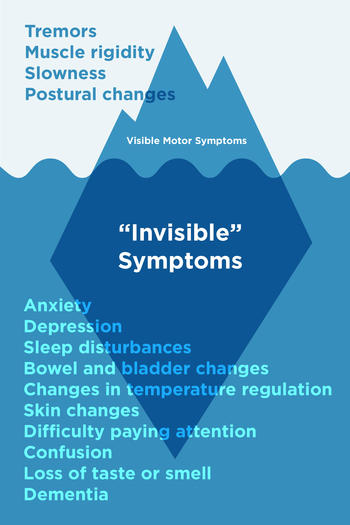Why is a Team-based Approach Important in the Treatment of Parkinson’s?

 A common metaphor for Parkinson’s disease (PD) is an iceberg. Sticking out of the water are the visible motor symptoms that most people are familiar with: tremors, muscle rigidity, slowness, and postural changes. But those are only the tip of the iceberg.
A common metaphor for Parkinson’s disease (PD) is an iceberg. Sticking out of the water are the visible motor symptoms that most people are familiar with: tremors, muscle rigidity, slowness, and postural changes. But those are only the tip of the iceberg.
Beneath the water is a much larger cluster of “invisible” symptoms, many non-physical, that occur with PD. These include anxiety or depression, sleep disturbances, bowel and bladder changes, changes in temperature regulation, skin changes, difficulty paying attention, confusion, loss of taste or smell, and dementia.
There are many questions that arise after a diagnosis of Parkinson’s, including:
- How quickly will my disease progress?
- What symptoms will I have, and how severe will they be?
- Will I respond well to conventional or integrative treatments?
- What kinds of changes will I need to make to my lifestyle?
These questions are normal, and there is no one answer that will fit everyone’s situation. How quickly the disease progresses through its five stages, and which symptoms will present, varies from person to person.
Build your PD team
It is important to have an integrated, team-based approach to support you as you manage the disease. In addition to your primary care physician and neurologist, you may need support of:
- Healthcare providers, such as nurses, who play a central role in connecting you to other team members, educating and supporting your medication regimen and looking at the whole person (body, mind, spirit) to enable you to live well with this disease
- A pharmacist to ensure that no medications taken, including those for PD as well as others, will interact with one another, as well as to eliminate as many unnecessary medications as possible
- Physical therapists to help you develop skills for better gait and balance
- Occupational therapists to help with cognitive challenges and all of your activities of daily living
- Speech therapists to address symptoms such as slurring or difficulty swallowing
- Social workers to help you find community resources, answer questions on legal and disability issues, and support you in “what if” planning
- Licensed mental health providers to help with mood and psychiatric symptoms
Manage your Parkinson's
You can take charge of your PD by:
- Working with a team of providers that includes all the roles listed above
- Using conventional medical treatments as well as integrative therapies (such as mindfulness meditation or massage)
- Making healthy lifestyle changes to promote overall wellbeing and manage symptoms
Just receive a diagnosis?
The Parkinson’s Foundation has compiled a booklet that answers frequently asked questions presented by people with Parkinson’s. Other excellent resources include the book Navigating Life with Parkinson’s Disease and the University of Minnesota’s Udall Center of Excellence for Parkinson’s Disease.
This Parkinson's disease resource is made possible through funding from the Medtronic Foundation.